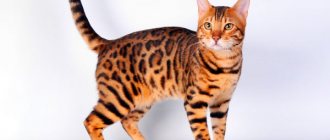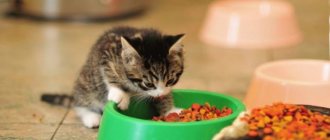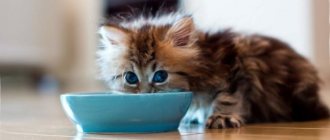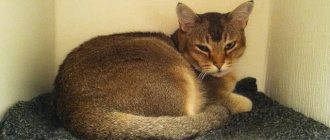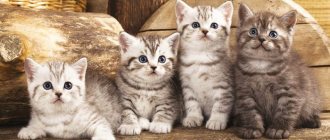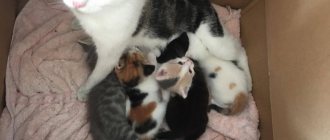Feeding mode
By 4-5 weeks, the kitten needs to develop a regular food intake routine. Feeding should be from 4 to 7 times a day, but these recommendations are average and can be adjusted up or down.
Recommended feeding frequency per day, depending on age:
- from 4 to 8 weeks – up to 7 times, night feeding should be avoided;
- from 8 to 12 weeks – up to 6 times;
- from 16 to 20 weeks – 5 times;
- from 5 to 9 months – 4 times;
- from 9 months to 1 year – three times a day.
A kitten over the age of 1 year should get used to eating twice a day with a mandatory 12-hour break.
Portions must meet the following sizes:
- from 4 to 6 weeks : 120 g of food per day;
- 8 weeks : from 160 to 180 g;
- from 12 weeks to 6 months : from 180 to 240 g, of which at least 40 g should be allocated to meat;
- 6-9 months : 180 g of food per day;
- from 10 months to 1 year : from 150 to 200 g.
You should at least approximately adhere to the amounts of food recommended by the veterinarian and the breeder. Overeating can cause major health problems in the future. An adult cat may develop obesity, pancreatitis, and diabetes.
Diet of a one-week-old kitten
If the mother cat does not have enough milk or the kitten grows up without her, the owners should know what is allowed to feed such babies. During this period, the most important thing is not to spoil their stomach and provide the body with all the necessary useful components. Therefore, the menu of a seven-day kitten includes the following:
- 500 ml of high concentration milk and chicken yolk, raw;
- 2.5 g of dry yeast and 15 g of milk (only dry and whole), 50 g of whole cow's milk;
- beaten chicken protein and 1 hard-boiled egg, 4 g of sugar (grape) and 1 g of vegetable oil. oils;
- corn oil - half a teaspoon, 50 ml milk and 1/2 yolk.
When the baby reaches four weeks of age, you can gradually begin to feed him.
Authorized Products
Small animals allowed on the menu:
- Meat – served raw, boiled or scalded with boiling water. Only low-fat varieties are suitable. Meat products should make up from 60 to 80% of the total daily food intake.
- Liver – no more than 2 times a week.
- Porridges – any are suitable, except semolina. All kittens are not fans of cereals, but they contain many substances that the growing body needs. It is recommended to mix meat and porridge in a ratio of 2 to 1.
- Vegetables - any, except potatoes, served boiled or raw.
- Chicken eggs - small pets can only be given the yolk. Its consumption is also allowed in raw form, but not more than once every 7 days. The yolk of quail eggs can be consumed simultaneously with the white.
- Fermented milk products - any, but with a minimum percentage of fat content. The exception is sour cream; giving it to kittens is strictly prohibited.
- Oil – not vegetable oil, but Vaseline is recommended.
- Brewer's yeast - affects the coat of a small pet.
It is recommended to give your kitten an apple as a fruit.
Natural menu
Natural nutrition is considered the most balanced.
Products for a natural diet:
- Lean meats. Veal, lamb, rabbit, turkey, and chicken are suitable for feeding kittens. The meat is given boiled, raw, in small portions, after having been doused with boiling water. Meat products should make up 80-90% of the total diet.
- Porridge . Cereals (rice, buckwheat, oatmeal, wheat) can be cooked in vegetable, meat, or fish broth. They should be well boiled. You can add minced meat, meat, vegetables, and herbs to the porridge.
- Dairy products . Kittens can be given milk, kefir, fermented baked milk, skim milk, calcined cottage cheese, natural yoghurts without dyes.
- Ocean fish, sea fish of low-fat varieties. It is given to a kitten no more than twice a week and only in boiled, stewed, baked form, after removing the seeds.
- Offal. They are introduced into the diet of kittens starting from 5-6 months. Served raw or boiled. Kittens can be fed chicken hearts, stomachs, and calf liver.
- Eggs. Once a week, offer the kitten one boiled yolk. Give raw eggs if you are confident in their quality and freshness.
- Greens, vegetables, fruits. They contain a large amount of vitamins, minerals, and beneficial organic compounds. Vegetables are given boiled, stewed, baked or raw. They are mixed with minced meat. For better digestibility, season the vegetables with a small amount of vegetable oil.
Food should always be fresh, at room temperature. After each feeding, wash bowls well with running water. Calculate portions correctly and adhere to the frequency of feedings and daily routine.
What is prohibited for a kitten
In order not to provoke complications in the functioning of the baby’s gastrointestinal tract, the following products should not be on the menu:
- freshwater fish;
- salt;
- Cow's milk is too harmful; goat's milk is best. In its absence, cow milk is allowed, but in dry form. Cow's milk can only be given to a kitten up to 12 weeks;
- purchased sausages;
- potatoes - the starch present in the vegetable is not digested or absorbed;
- any legume products - cause fermentation and flatulence;
- cheese is a very fatty product that negatively affects the pancreas;
- pork, lamb is also not recommended;
- any sweets (homemade and store-bought);
- flour and bakery products.
It is not allowed to introduce ready-made industrial food into the kittens’ menu that is not appropriate for their age.
What not to feed a kitten
Some owners who do not know how to properly feed kittens give them foods that are undesirable for consumption.
- Salted, fried, smoked, peppered, spicy, fatty. These foods cause inflammation of the digestive tract.
- Milk. At the age of 3-4 months, it is better to give it up, since the kitten’s digestive tract is no longer able to digest lactose.
- Citrus. They are not digestible in cats. Moreover, they cause irritation of the mucous membrane of the stomach and esophagus, which leads to an attack of vomiting followed by dehydration.
- Bones. Cats chew bones into many fragments, which pass through the gastrointestinal tract and injure the mucous membrane. As a result, bleeding may occur.
- Chocolate and other sweets. They have a toxic effect on the kitten’s body.
- Vegetables of the nightshade family, as well as onions and garlic. The body does not digest these foods.
- Avocado, grapes and raisins. They contain a poisonous toxin.
Diet recommendations according to the age of the kitten
A 2-4 month old kitten has already developed sharp teeth; he should be able to eat from a bowl himself. Intensive growth and development of the animal requires a balanced and varied diet. The basis of the diet is lean meat, vegetables (preferably boiled) and porridge. The cereal should be boiled in a large amount of water so that the resulting porridge has a liquid consistency. Half of the diet consists of low-fat sour milk.
From 4 to 6 months, the animal’s body actively builds and strengthens muscle mass. The basis of the diet is beef and chicken, cut into small cubes and offal. Fermented milk products are allowed, but in smaller quantities. Cow's milk should be removed from the diet. Porridges are cooked with less water to make the consistency thicker. It is recommended to introduce boiled and raw vegetables, cucumbers, and zucchini into the kitten’s diet.
The animal's nutrition expands from 6 months. All products should be cut into large cubes, and porridge should be cooked more crumbly. It is during this period that it is recommended to include industrial feed in the diet, according to the age category of the animal.
Approximate diet for a week with the permissible frequency of consumption of certain foods
| Product | Quantity per week |
| Beef | Daily |
| Boiled chicken | Up to 4 times. |
| By-products (chicken and cow) | Up to 3 times, and the liver - no more than once. |
| Fish - exclusively boiled, without bones, preference is given to sea fish | Cat - up to 2 times, cat - no more than 1 time. |
| Chicken egg yolk | Up to 2 times. |
| Porridge on water - oatmeal, rice | Daily. |
| Fermented milk products | Daily. |
| Low fat cottage cheese | Up to 4 times. |
| Vegetables (cooked or raw) | Up to 3 times. |
| Greens – spinach, wheat germ | Up to 2 times, as an additive to meat. |
| Brewer's yeast | Up to 4 times. |
The kitten's bowl should always contain clean drinking water (boiled or filtered, purified). It should be changed daily.
Feeding 3 month old kittens with natural products
At this age, kittens begin to refuse cat milk, but may still require it out of habit. Under no circumstances should you try to exchange cat's milk for cow's milk. It has a different composition, and at this age, kittens can do without milk altogether. This will only benefit them.
Natural food products
The list of natural products, although small, is sufficient for freedom of choice:
1. Meat. This is the best product for feeding kittens. But here you need to remember that chicken is often allergenic, which is very dangerous in childhood. Therefore, it is better to start with rabbit, turkey, beef and other safe types of meat. If you buy food in a store, you can give it raw. But when purchasing products from a private shopkeeper, be sure to thoroughly boil them to eliminate the possibility of helminth infection.
Important! The exception is pork and other fatty meats. They cannot be given.
2. Meat by-products. Since meat is usually quite expensive, many people buy their kittens not natural meat, but meat by-products. These include the liver, lungs, scars, intestines, brain, heart and other internal organs. The cooking rules are the same as for meat. Meat and meat by-products are the basis of the diet, which should make up at least half, and preferably 70-80% of the daily menu.
Important! Liver should not be given too often (2-3 times a month is enough), since its composition is too specific a product.
3. Bones. Separately, among meat by-products, bones need to be considered because of their very specific composition. Firstly, kittens 3-4 months old are unlikely to be able to chew bones. Secondly, pets absorb much less nutrients from bones. So they must be ground and boiled.
4. Fermented milk products. This is not milk, but kefir, fermented baked milk, cottage cheese and others. Kittens should consume milk from their mother, since each type of animal needs its own composition of nutrients. Also, you should not give kittens foods that are too fatty: cheeses, sour cream, cream and others (anything above 5% fat). You can feed cottage cheese and kefir in any form without restrictions. There is no harm from them.
5. Eggs. Feeding an egg once a week is very beneficial; it has a beneficial effect on the coat, claws and teeth. There is no need to give too often. You can feed them both raw and boiled. The latter option is preferable, since the kitten will receive more calories, will not be able to stain the floor or face, and will not choke on the shell. You cannot fry eggs, as this will allow oil to get into the product.
6. Porridge. Cats are generally quite indifferent to cereals, unlike dogs, who can eat them mixed with meat. Among cereals, only buckwheat and rice are suitable. Semolina should not be given due to too many carbohydrates. Before serving, be sure to cook and mix with meat. Porridge should not exceed 50% of the pet’s daily diet.
7. Green vegetables. Even in the wild, cats eat blades of grass in a meadow or greens from the rumen of a killed animal. Kittens do not absorb any useful vitamins and microelements from vegetables, but they need them for intestinal motility.
Feeding 3 month old kittens
Feeding adult cats
Feeding a kitten at six months
8. Fish. It is better to avoid fish, as it provokes urolithiasis. But cats (females!) can eat it in small quantities. Only lean river fish is suitable, since it does not cause such an excess of phosphorus in the urine. Be sure to cook before use.
Remember and do not give your pet the following prohibited foods:
- Semi-finished meat products: sausage, pate, lard, etc. They are too greasy and spicy.
- Pasteurized cow's milk. The kitten’s body simply will not digest it.
- Carbohydrates: sugar, flour products, pasta, etc. The kitten will not even try most of these products. But he can eat some (for example chocolate). After which he will die in wild agony, since these products are extremely dangerous for him.
- Fruits and berries. The only fruits you can eat are apples and pears. Everything else is prohibited.
- Some vegetables: potatoes, beets, cabbage, other root vegetables.
Approximate diet
Up to 1.5-2 months, kittens feed exclusively on mother's milk. At this time, they are allowed to give only fermented milk products. At 2-3 months, kittens should receive adult food along with mother's milk. It is normal for pets to eat from the same bowl with their mother. If your animal eats high-quality food, then you don’t have to give the kittens any special diet; let them eat with the cat.
If you are afraid that adult food is too allergenic (for example, you often feed your pet chicken), then it is better to switch the cat herself to the “children’s” menu, since the kittens will still eat what their mother eats. This is a normal instinct. Moreover, it may be difficult to transition a kitten to an adult diet if it does not receive an example from its mother.
When you buy a kitten that is 3-4 months old, at first you need to feed it strictly the same as the previous owners fed it. This is done in order to minimize stress so that the pet feels more confident in its new home. New products should be introduced gradually and after 1.5-2 months, when the animal adapts to the home.
How many times a day
This depends on the age of the kitten and its weight. At 3 months, meat and meat by-products should account for 8% of the kitten’s weight. That is, a pet weighing 500 grams needs to eat 40 grams of meat per day. If the pet remains hungry, then you can supplement it with fermented milk products (they are given ad libitum) or cereals.
However, these are only approximate figures, since each animal has a unique metabolism. Even kittens from the same litter can eat differently. Therefore, in general, you need to focus on the pet’s condition and whether it is gaining weight or stunted in growth.
How you distribute this food throughout the day does not matter much. The only recommendation is that a kitten at 3 months old should eat 3 times a day. By six months, it is necessary to reduce the frequency of feedings to 2 times.
Raw or cooked foods
Even humans can digest raw meat, and cats will eat it with the same pleasure as cooked meat. The danger is not the raw meat itself, but the worms it may contain. Therefore, if you buy food in a shop, at the market or from your grandmother on the street, then you must cook it. Store-bought, frozen meat can be fed raw. The same applies to fish, eggs, vegetables and other foods. The exception is bones, which it is advisable to grind before cooking.
Do kittens need commercial food?
There is no clear opinion among veterinarians regarding the need to give a kitten industrial food - dry or wet canned food. Many agree that this type of feeding is only suitable for owners who do not have time to prepare separate meals for kittens.
Other veterinarians and breeders believe that only by introducing industrial diets into the menu can one give the pet’s body enough vitamins and minerals. As practice shows, giving kittens industrial food is not only possible, but also necessary. The main thing is to know how to choose and enter them correctly.
How to transfer a kitten to industrial food
Most owners prefer ready-made food. This diet is convenient for owners who are away from home for a long time. In addition, it is possible to give the animal food for future use if it needs to go away for several days.
Industrial food is also useful for kittens, since it contains useful minerals that are almost impossible to obtain in the proper quantities from natural food.
The optimal age for introducing a pet to commercially produced food is 5 months, when the kitten is already fully eating the foods it is allowed to eat. It is recommended to accustom you to industrial feed according to the following scheme:
- 1 day – 75% of the food that the kitten is accustomed to, and 25% of purchased food;
- 2 days – usual, natural food and feed should be in equal volumes;
- Day 3 – 75% new food and 25% natural food;
- 4 days - the kitten is completely transferred to industrial food.
If the kitten refuses to eat dry food on the first day and does not even touch it, the process of transferring it to this type of feeding should be postponed for several days.
Feeding small kittens aged 1 month
A baby at this age still needs to be fed with formula milk, and solid foods must also be included in the pet’s menu - cheese, porridge, hard-boiled yolk, cottage cheese, fish and meat.
If from the very first months of a little kitten’s life you introduce fruits and vegetables into his diet, this will be great and very, very important for him. Many cats treat fruits and vegetables favorably. Some eat apples and cucumbers, others are ready to sell their souls for a piece of watermelon, others are partial to carrots, and still others cannot be torn off by the tail from persimmons, ripe melon or canned green peas. And the sooner you offer such products to your ward, the more likely it is that he will appreciate them.
Cats are conservative; they don’t like to change their habits too much. If you didn’t teach it in childhood, it will be much more difficult to teach it as an adult. Give your little kitten vegetables both raw and grated. I didn’t appreciate the pieces, grind them into puree and forcefully add them to the main diet.
It could be a cucumber, an apple, a carrot, various greens, even young nettles. It is healthier to feed raw vegetables, seasoned lightly with vegetable oil. Why do this? It has been proven that most vitamins are better absorbed with oil, in which they dissolve well.
When preparing a complete diet for a kitten, you must remember that cats by nature are predators. It is this fact that should determine the nutrition of a small kitten, which must certainly include meat products. Kittens lead an active lifestyle, grow quickly and have an excellent appetite. At this stage, it is advisable not to overfeed the pet, giving preference to the frequency of feedings rather than increasing portions.
Diet rules with industrial feeds
If the owner decides that his pet will only consume ready-made diets, whether dry or canned, from this moment on it is recommended to adhere to certain rules:
- Natural food and industrial nutrition are combined only during the period of accustoming the kitten to store-bought canned food or dry food. In the future, the pet should only be on one type of feeding. Constantly combining natural and industrial food can lead to an imbalance of vitamins and nutrients, which will not have the best effect on the condition and functioning of the digestive system and the entire body.
- A kitten accustomed to commercial diets should always have fresh, clean water in its bowl. For an animal that eats only dry food, water is the only source of liquid. The owner must ensure that his pet regularly drinks water. If the kitten does not drink it often, you should train it. Lack of fluid when eating dry food can further provoke the development of urolithiasis.
- It is recommended to give preference in industrial food to wet canned food, as they are more nutritious, tastier and contain moisture.
- To make the canned food even tastier and more aromatic, especially if the animal has difficulty getting accustomed to ready-made food, it is recommended to heat the jar to 40°.
- It is not recommended to give dry and wet food at the same time, mixing them in the same bowl. The optimal option for feeding a kitten: the base is dry food, and canned food is periodically included in the menu.
- You only need to purchase a ready-made diet with a note indicating the appropriate age. Giving small animals the same industrial food that is intended for adults is prohibited.
All feeds differ from each other in composition, different amounts of vitamins and mineral elements in them. The ideal option to choose food for your pet is to consult a veterinarian.
The owner himself will also be able to determine by the condition and appearance of the pet whether the chosen diet is suitable for him. If the kitten is active, mobile, has thick, shiny fur, there are no problems with stool and other signs indicating problems with digestion, then dry or wet food has been chosen correctly and all the necessary nutrients are supplied to the body.
Feeding kittens with ready-made formulas
If you decide to feed your baby with specialized formulas, it is important to adhere to the following recommendations:
- It must be remembered that the basis of a kitten’s diet should still be soft, canned food. Dry food can be used 1-2 times a day;
- The use of additional additives with this diet is not necessary; specialized animal feed already contains all the necessary vitamins;
- During the demi-season, it is important to feed the kitten with fresh grass. Wheat or oat seeds for cats can be purchased at a pet store.
When feeding kittens with dry food and canned food, it is also important to carefully monitor portion sizes and not overfeed the animal.
Whatever feeding method you choose is best for your ward, it is important to always follow a few simple rules:
- Do not offer your kitten sweet food, sugar is very harmful to its health;
- Do not allow him to steal food from the master's table; the digestive system of cats is very different from the human one, and some foods from the master's table can seriously harm him;
- Carefully monitor the portion sizes for the animal and the cleanliness of its dishes;
- Maintain the kitten's drinking regime.
By following the recommendations outlined above, you can easily feed a kitten, getting a healthy, grateful and cheerful friend. And your days together will be filled with only positive emotions. And the cat Behemoth, walking around the house with a pickled mushroom pricked on a fork, was invented by the writer M. Bulgakov. Cats do not eat pickled mushrooms. It's harmful to them. And it tastes disgusting, according to a cat.
Classification and features of industrial feeds
On mobile, you can scroll the table horizontally with your finger.
| Name | Advantages | Flaws |
| Economy class Diamond meal Doctor Zoo Vaska Whiskas Darling, etc. | low cost |
|
| Premium class Nutro nuggets Flatazor Pro Pac Happy Cat Royal Canin Doctor Alders, etc. |
|
|
| Super premium class ProPlan Petreet Hills Nutro Choice Royal Canin Bosh, etc. |
| the cost is quite high |
| Holistics Innova Acana Canidae Eagle Pack Holistic Select Felidae, etc. |
| the cost is high, not affordable for everyone |
Economy or medium food refers to a type of industrial food that is secretly called fast food for representatives of the cat world. This is the cheapest, most budget option, which has many disadvantages. Such food is made from the cheapest, low-quality products.
There is practically no meat in the composition. The meat part is represented mainly by waste. To enhance the taste of these products, chemical preservatives, flavor enhancers, flavorings, as well as catnip, which is an analogue of valerian, are added to the composition. Giving such food on a regular basis is highly discouraged, as this can lead to serious problems with the digestive system and health of the animal.
Super-premium class - they cost more than economy class, but they do not always meet the requirements. The advantage of such foods is that they do not contain food colors or flavors. They contain more meat than in economy category feeds, and the taste is a level higher. These types of feeds are quite well accepted by the animal’s digestive system.
Holistics are the most expensive class of cat food, but their quality is appropriate. The composition contains a large amount of natural, good meat. No dyes or flavor enhancers. The composition of the food fully corresponds to natural nutrition.
Recommended canned foods
On mobile, you can scroll the table horizontally with your finger.
| Name of food | Advantages | Flaws |
| Bosh Sababelle Super premium class |
| The food contains large quantities of maize and cellulose - components that can provoke a food allergy in a kitten. |
| Pro Plan Junior Premium class |
| The composition contains a high concentration of protein of plant origin. The food contains corn and soy - products that provoke allergic reactions. Preservatives are also present in the composition. |
| Hills Premium class |
| A high concentration of carbohydrates, which are poorly absorbed by the kitten’s digestive system, there are components that can cause allergies, canned food contains a lot of water and broth. |
